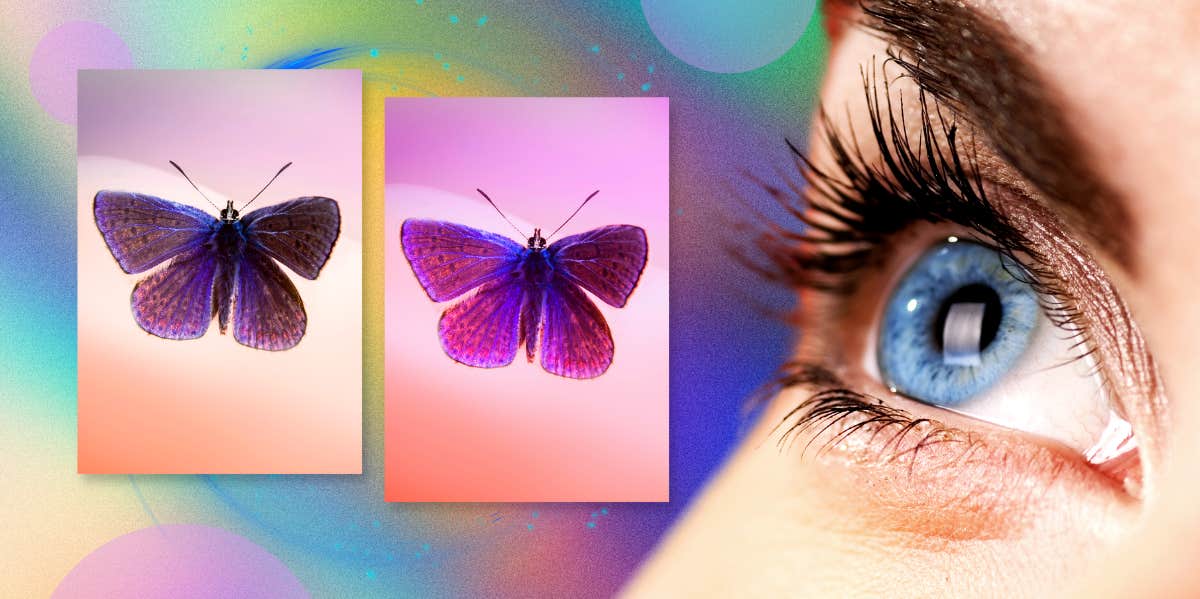Why What You See As 'Red' May Be Someone Else's Blue
Everything is not as you see.
 Nejron, freeject, Nathanx1 / Getty Images via Canva
Nejron, freeject, Nathanx1 / Getty Images via Canva Have you ever argued with someone over the color of an object? If you remember the viral debate about what color a certain dress was, it turns out, there's actual science behind why everyone was right.
Color perception is a concept that has spiked in popularity thanks to TikTok, with a trendy theory called the "my red is not your red" theory going viral. In fact, the theory says that the color red may not actually appear as red to someone else.
But what does that mean? How does color perception work, and what exactly is the theory all about?
What is color perception?
Color perception is exactly that: how we perceive color. Although, it's a lot more than just how we see color.
Color perception is how we see color, how we process it, how we recognize it, and how it exists to us. In other words, there's a lot that goes into our color perception that allows for hundreds of variations of color to exist.
To see color, we usually have three light receptors in our eyes that are enhanced to sense different wavelengths (i.e., color) of light. However, there are times when a person has a damaged receptor or doesn't have one due to a genetic variation.
This can lead to an alteration in your color perception. You have heard of people who are color-blind, and this is the reason behind it.
But do you know what else can alter our perception of color? Almost anything.
From our sex, our age, where we live, what season it is, and even our own iris color, these factors can all change the way we see color.
This brings us back to that infamous dress. In 2015, the internet was taken by storm when the color of a certain dress was debated to be either blue and black, or gold and white.
The debate sparked arguments and disputes, because everyone thought they had the right answer based on what they saw. How could anyone be wrong?
Now, we have the science behind why every person was right. The dress was blue and black AND white and gold.
It was all because everyone has a different color perception. It also had a lot to do with the lighting our eyes were seeing the dress in, as well as the surrounding colors we were perceiving.
What is the 'my red is not your red' theory?
The "my red is not your red" theory is that color is an illusion and only exists in our minds. Therefore, someone's blue could actually be red to someone else. The theory also leans into the fact that you truly can't describe a color to someone.
Many are calling it a conspiracy theory, while others believe it's the realest thing they have ever heard.
TikToker MJ Patek posted a video discussing the "my red is not your red" theory. "Our brains created color," he says, going on to explain how we created color with the electromagnetic spectrum.
Patek says that no one can ever truly know if we are seeing the same color, just that we are all taught what each specific color is.
He uses a strawberry as an example. "How would you really know that when I look at a strawberry, it's this color to me (shows red), but this color to you (shows blue)?" It turns out, there is no way — "We just both know to call this specific color red."
Patek explains the idea that we can't really describe what a color is, adding, "Can you explain the color red to me? Or the color blue?"
However, he does say that, "You could say that red is hot and blue is cold, but to a person who has never seen color before, that just wouldn't make sense." And he's right.
Another TikToker with the username Psychopoly added his own take on the "my red is not your red" theory.
He says that this theory could be the reason why we have a favorite color. "Seriously, go ask someone how they see color," he urges.
It's just something to think about next time someone tells you the sky is blue.
Deauna Nunes is an associate editor for YourTango who covers pop culture, lifestyle, astrology, and relationship topics. She's had bylines in Emerson College's literary magazine, Generic and MSN.

